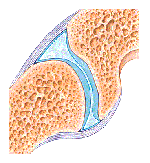As shown in the drawings on the right, there are several kinds of synovial joints in our bodies:
- Ball and socket joints, such as the hip joint. These allow a wide range of movements.
- Condyloid (or ellipsoid) joints, such as the knee. When the knee is extended, there is no rotation; when it is flexed, some rotation is possible. A condyloid joint is where two bones fit together with an odd shape (e.g., an ellipse), and one bone is concave, the other convex. Some classifications make a distinction between condyloid and ellipsoid joints.
- Saddle joints, such as at the thumb (between the metacarpal and carpal). Saddle joints, which resemble a saddle, permit the same movements as the condyloid joints.
- Hinge joints, such as the elbow (between the humerus and the ulna). These joints act like a door hinge, allowing flexion and extension in just one plane.
- Pivot joints, such as the elbow (between the radius and the ulna). This is where one bone rotates around another.
- Gliding joints, such as in the carpals of the wrist. These joints allow a wide variety of movement, but not much distance. (Not shown.)

The Joint Capsule
The ends of the bones are coated in cartilage of varying and sometimes uneven thickness. Cartilage is softer and more pliable than the bone itself due to a higher proportion of proteoglycans to collagen. In some joints, even with the cartilage lining of the ends of the bones, the bones do not fit together snugly. In these cases, multiple folds of fibro-cartilage are employed, such as in the meniscus of the knee, to allow the bones to slide smoothly.
Around all the synovial joints is the synovium, a membrane that covers all the surfaces in the joint. The synovium forms the capsule of the joint and secretes synovial fluid into it, to keep the articulating surfaces lubricated. As we age, the synovial fluid begins to dry up. Like a leaf in autumn, we grow dryer and smaller, more yin-like. This fluid (as was discussed in the section on Ground Substances) is made up of water-attracting molecules like hyaluronic acid and chondroitin-sulfates. We will discuss this drying up more in the next section.

(Next: A Demonstration )
